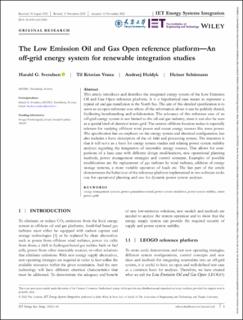| dc.contributor.author | Svendsen, Harald Georg | |
| dc.contributor.author | Vrana, Til Kristian | |
| dc.contributor.author | Holdyk, Andrzej | |
| dc.contributor.author | Schümann, Heiner | |
| dc.date.accessioned | 2022-12-08T07:49:05Z | |
| dc.date.available | 2022-12-08T07:49:05Z | |
| dc.date.created | 2022-12-05T08:50:13Z | |
| dc.date.issued | 2022 | |
| dc.identifier.citation | IET Energy Syst. Integr. 1–14 (2022). https:// doi.org/10.1049/esi2.12085 | en_US |
| dc.identifier.issn | 2516-8401 | |
| dc.identifier.uri | https://hdl.handle.net/11250/3036625 | |
| dc.description | The data that support the findings of this study are openly available in Zenodo at https://doi.org/10.5281/zenodo (7373223) | en_US |
| dc.description.abstract | This article introduces and describes the integrated energy system of the Low Emission Oil and Gas Open reference platform. It is a hypothetical case meant to represent a typical oil and gas installation in the North Sea. The aim of this detailed specification is to serve as an open reference case where all the information about it can be publicly shared, facilitating benchmarking and collaboration. The relevance of this reference case of an off-grid energy system is not limited to the oil and gas industry, since it can also be seen as a special kind of electrical micro grid. The remote offshore location makes it especially relevant for studying offshore wind power and ocean energy sources like wave power. The specification has an emphasis on the energy system and electrical configuration, but also includes a basic description of the oil field and processing system. The intention is that it will serve as a basis for energy system studies and relating power system stability analyses regarding the integration of renewable energy sources. This allows for comparisons of a base case with different design modifications, new operational planning methods, power management strategies and control concepts. Examples of possible modifications are the replacement of gas turbines by wind turbines, addition of energy storage systems, a more variable operation of loads etc. The last part of the article demonstrates the behaviour of the reference platform implemented in two software tools: one for operational planning and one for dynamic power system analyses. | en_US |
| dc.language.iso | eng | en_US |
| dc.publisher | John Wiley & Sons Ltd | en_US |
| dc.rights | Navngivelse 4.0 Internasjonal | * |
| dc.rights.uri | http://creativecommons.org/licenses/by/4.0/deed.no | * |
| dc.subject | smart power grids | en_US |
| dc.subject | power system stability | en_US |
| dc.subject | power system simulation | en_US |
| dc.subject | power generation control | en_US |
| dc.subject | energy management systems | en_US |
| dc.title | The Low Emission Oil and Gas Open reference platform—An off-grid energy system for renewable integration studies | en_US |
| dc.title.alternative | The Low Emission Oil and Gas Open reference platform—An off-grid energy system for renewable integration studies | en_US |
| dc.type | Peer reviewed | en_US |
| dc.type | Journal article | en_US |
| dc.description.version | publishedVersion | en_US |
| dc.rights.holder | © 2022 The Authors. IET Energy Systems Integration published by John Wiley & Sons Ltd on behalf of The Institution of Engineering and Technology and Tianjin University | en_US |
| dc.source.pagenumber | 1-14 | en_US |
| dc.source.journal | IET Energy Systems Integration | en_US |
| dc.identifier.doi | 10.1049/esi2.12085 | |
| dc.identifier.cristin | 2088403 | |
| dc.relation.project | Norges forskningsråd: 296207 | en_US |
| cristin.ispublished | true | |
| cristin.fulltext | original | |
| cristin.qualitycode | 1 | |

